This Date in Bigfoot History: October 5, 1958
Posted by: Loren Coleman on October 5th, 2008

October 5, 1958
At a road construction site in Bluff Creek, California, Gerald Crew finds big tracks in August and then again on October 1 and 2, 1958. He is told by his fellow workers, some of whom are Hoopa Indians, the maker is a hairy forest giant. Crew, using plaster of Paris, thanks to instructions from taxidermist Bob Titmus, makes a replica of the large print at the site on October 3, 1958.
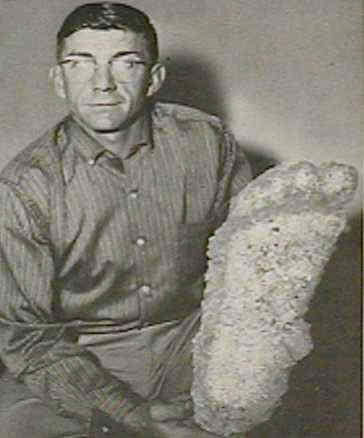
Jerry Crew brings his cast to the local newspaper and shows it to the editor, Andrew Genzoli who publishes his illustrated story in the Humboldt Times on October 5, 1958. Genzoli repeats the name that he hears from the all-male construction crew and their wives (especially Jess Bemis and her letter to Genzoli), that the creature that made the track is called “Bigfoot.”

The publication of that photograph of Crew holding an enormous foot-shaped plaster cast becomes a turning point in the pursuit of hairy wild hominoids in North America, and soon the world. Everybody wants to see whatever was making such imprints, and the public becomes interested in learning more about “Bigfoot.”
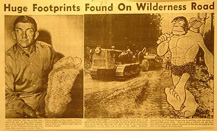
The surviving copy of that Jerry Crew 1958 cast from Bluff Creek, California, clearly shows it does not match the fakes revealed by the Ray Wallace family, after Ray Wallace died in 2002.


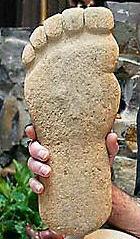
While those wooden Wallace hoaxes may have been used to create other contemporary dubious prints, they do not mirror the Jerry Crew “Bigfoot” cast from October 1958.
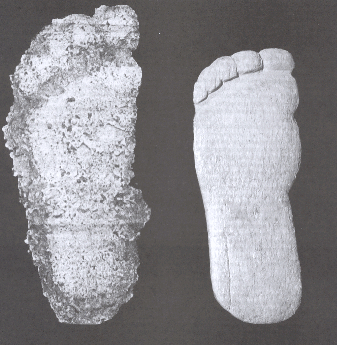
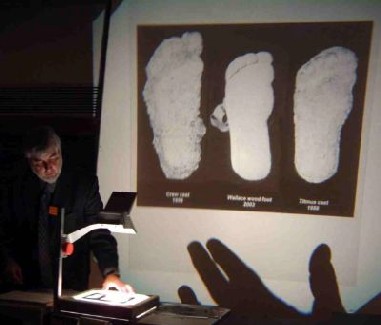
Sources: The Field Guide to Bigfoot and Other Mystery Primates (NY: Anomalist Books, 2006) and Bigfoot! The True Story of Apes in America (NY: Simon and Schuster, 2003)
About Loren Coleman
Loren Coleman is one of the world’s leading cryptozoologists, some say “the” leading living cryptozoologist. Certainly, he is acknowledged as the current living American researcher and writer who has most popularized cryptozoology in the late 20th and early 21st centuries.
Starting his fieldwork and investigations in 1960, after traveling and trekking extensively in pursuit of cryptozoological mysteries, Coleman began writing to share his experiences in 1969. An honorary member of Ivan T. Sanderson’s Society for the Investigation of the Unexplained in the 1970s, Coleman has been bestowed with similar honorary memberships of the North Idaho College Cryptozoology Club in 1983, and in subsequent years, that of the British Columbia Scientific Cryptozoology Club, CryptoSafari International, and other international organizations. He was also a Life Member and Benefactor of the International Society of Cryptozoology (now-defunct).
Loren Coleman’s daily blog, as a member of the Cryptomundo Team, served as an ongoing avenue of communication for the ever-growing body of cryptozoo news from 2005 through 2013. He returned as an infrequent contributor beginning Halloween week of 2015.
Coleman is the founder in 2003, and current director of the International Cryptozoology Museum in Portland, Maine.










We know Bigfoot-type reports did not just begin 50 years ago – they go back a century or more before that. But this is the 50th birthday of Bigfoot as a media phenomenon.
So where did the print in the Crew cast come from? We have a claim by the family of a man named Ray Wallace, who, after Wallace died in 2002, claimed that Wallace had “invented Bigfoot” by making the original tracks, and they showed the press the wooden feet Wallace had supposedly used to make said tracks.
The problem? Oddly, none of the “Bigfoot Hoax Solved” articles that flooded out mentioned that, if you put Wallace’s fake foot next to a surviving cast of the Crew track, they don’t match. They’re not even close. Only the cryptozoologists pointed this out, and no one seems to have paid much attention.
That doesn’t mean Wallace had no role. It’s possible he had carved earlier, now-lost feet which did match the Crew cast. But whether the tracks in the woods were made by Wallace, another hoaxer, or an unknown primate, their appearance in the Times set off a modern American mystery.
There are two possible situations behind this whole business.
Option One is that a huge upright ape, of which we have no fossil record, is hiding out in the still-wild corners of North America, and doing such a good job of it that no specimen has ever been killed, accidentally or deliberately. (Claims of specimens found or taken but lost have no more weight than any other sighting report.)
Option Two is that hundreds of people have mistaken something mundane for a huge upright ape and that a startling number of hoaxers all over the continent have left fake prints, encouraged rumors, and told false tales to the press (and, in some cases, to legal authorities.
Neither of these alternatives seems credible, but one has to be true. I lean toward the second, but I sincerely hope for the first.
Family protecting his name no doubt with the fakes.